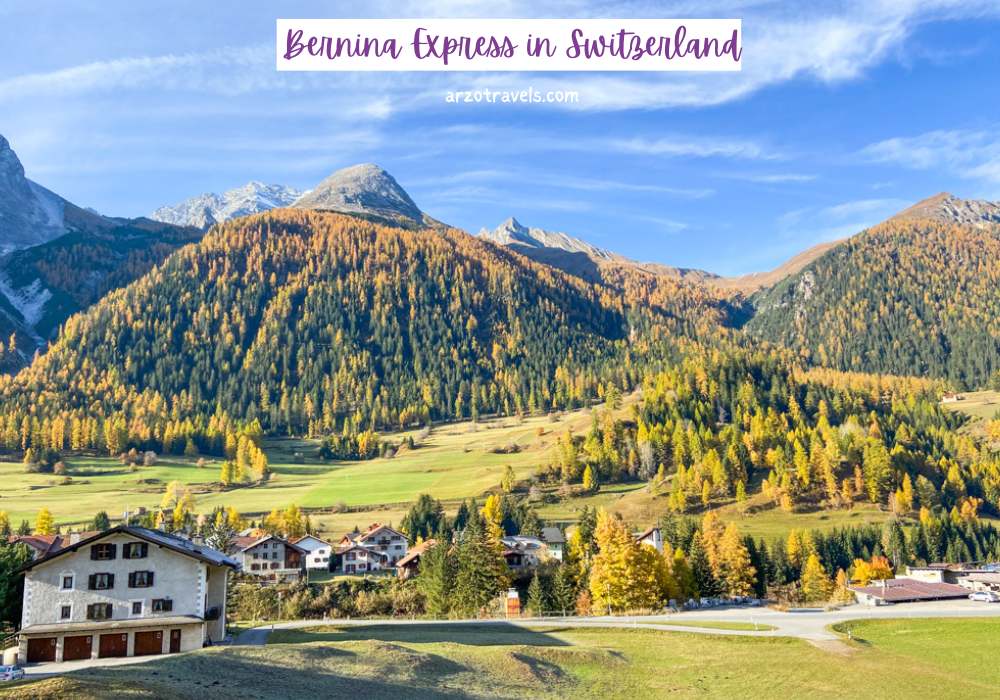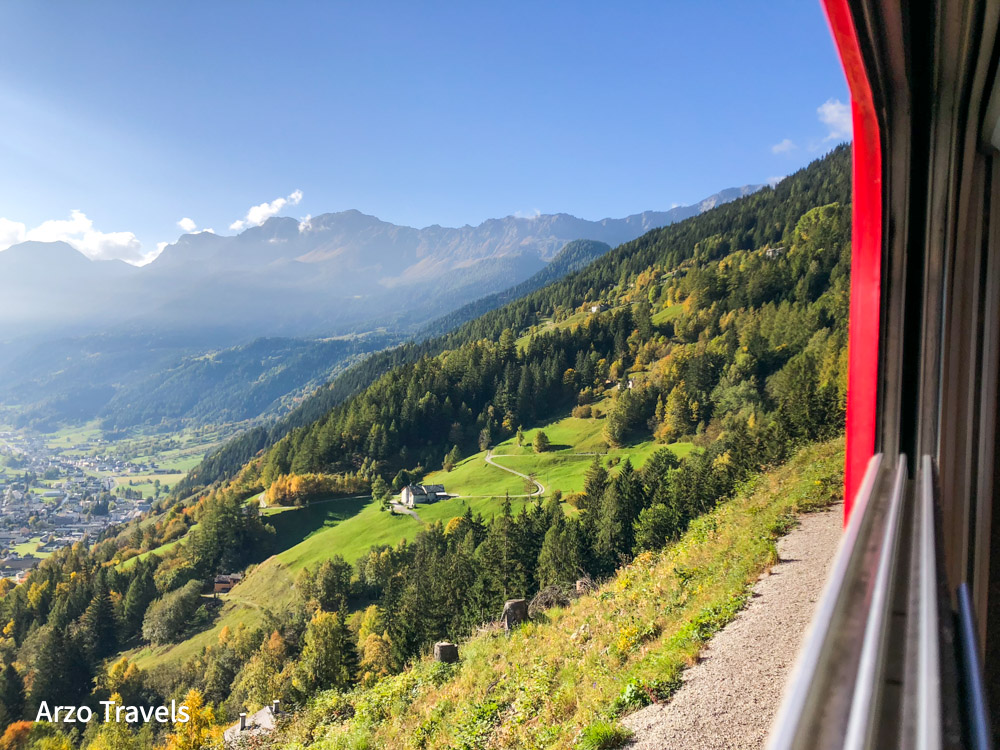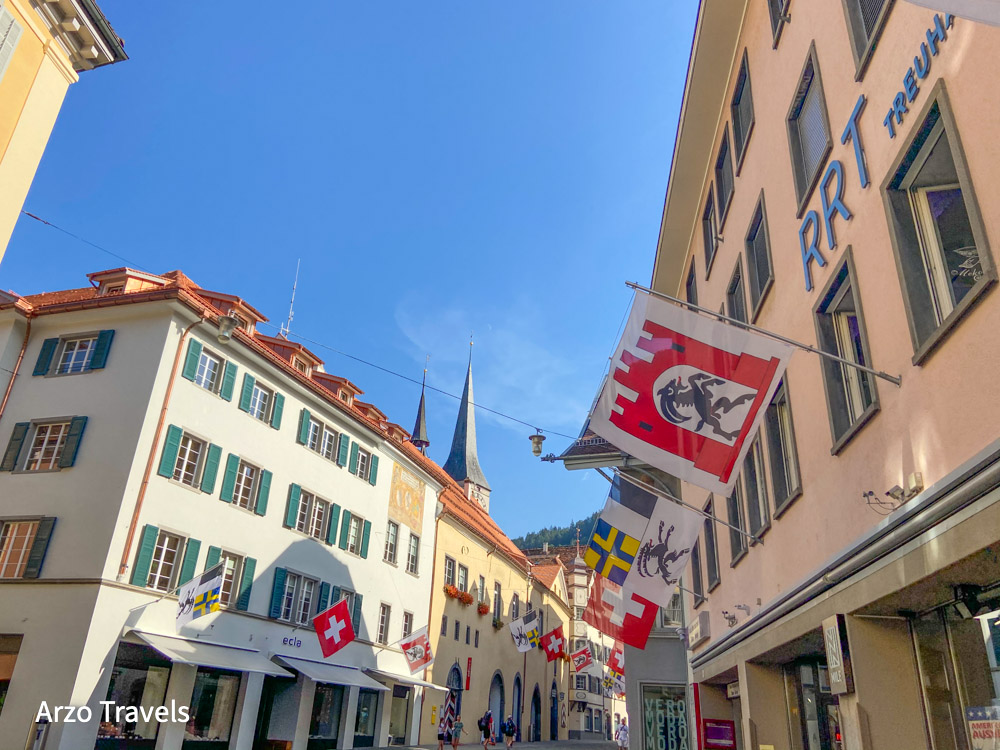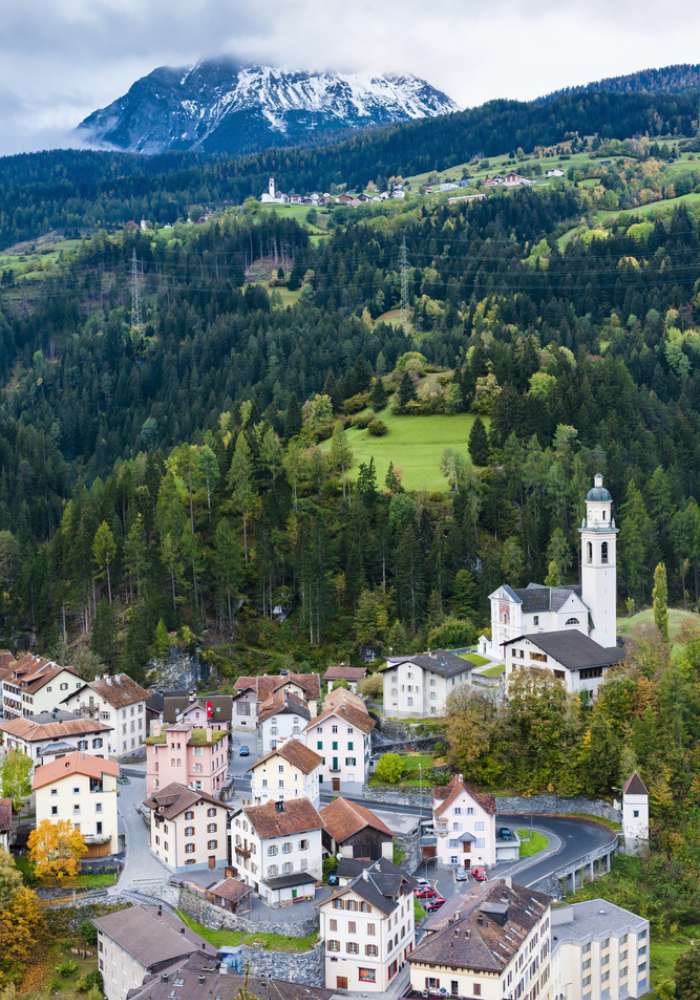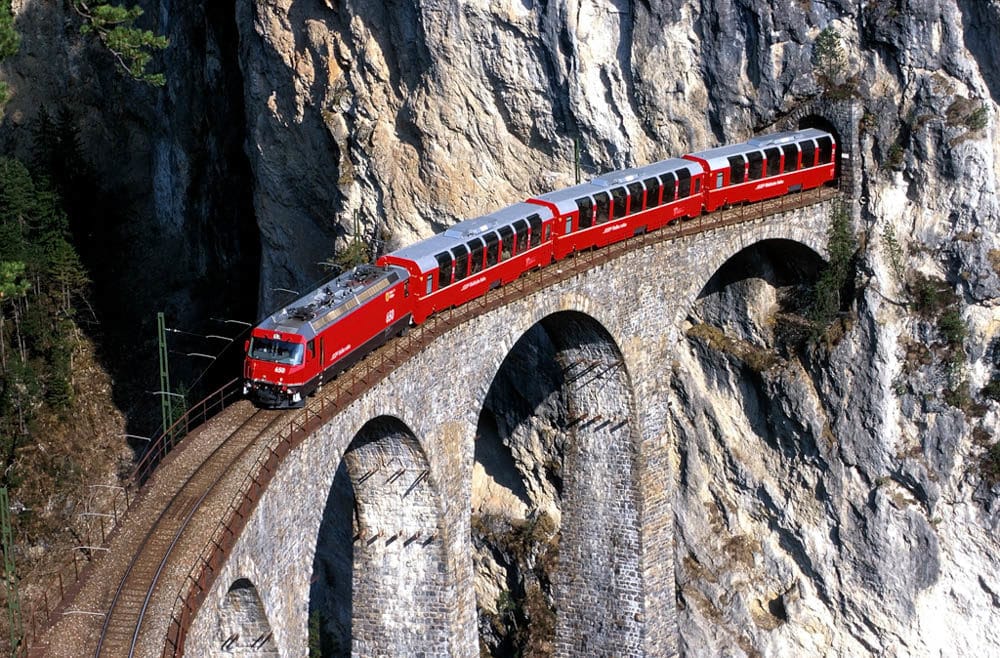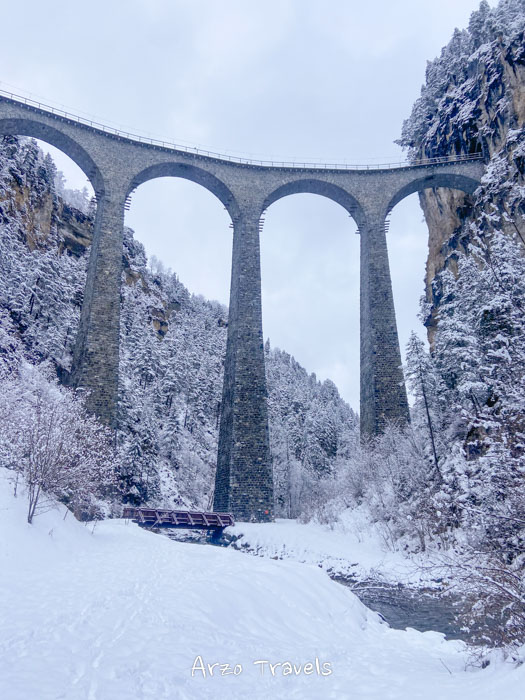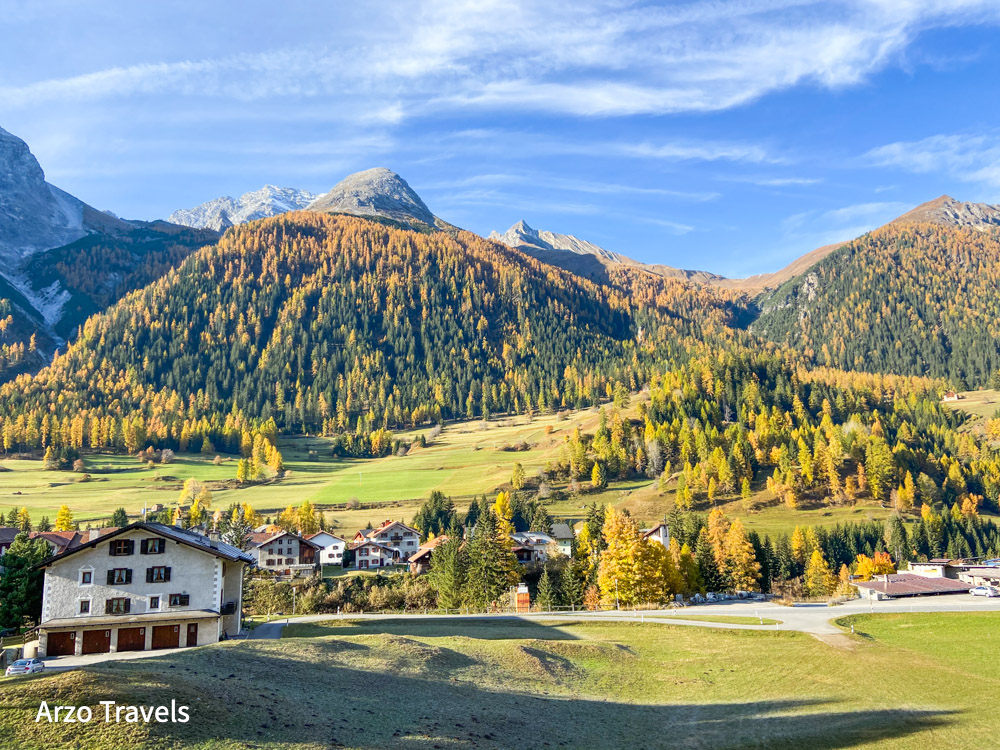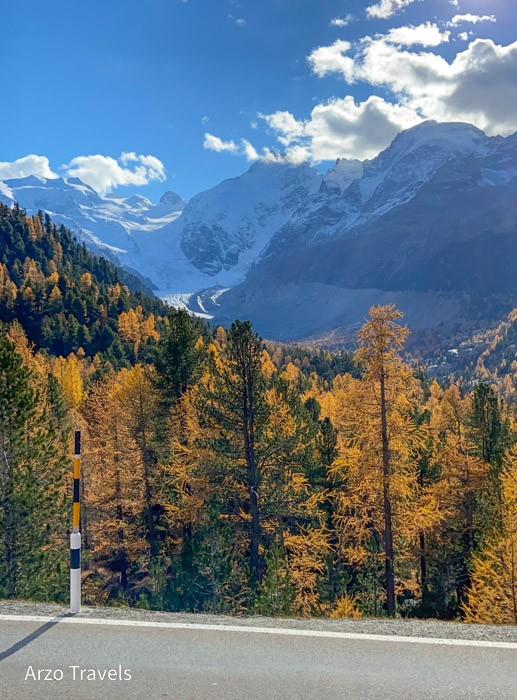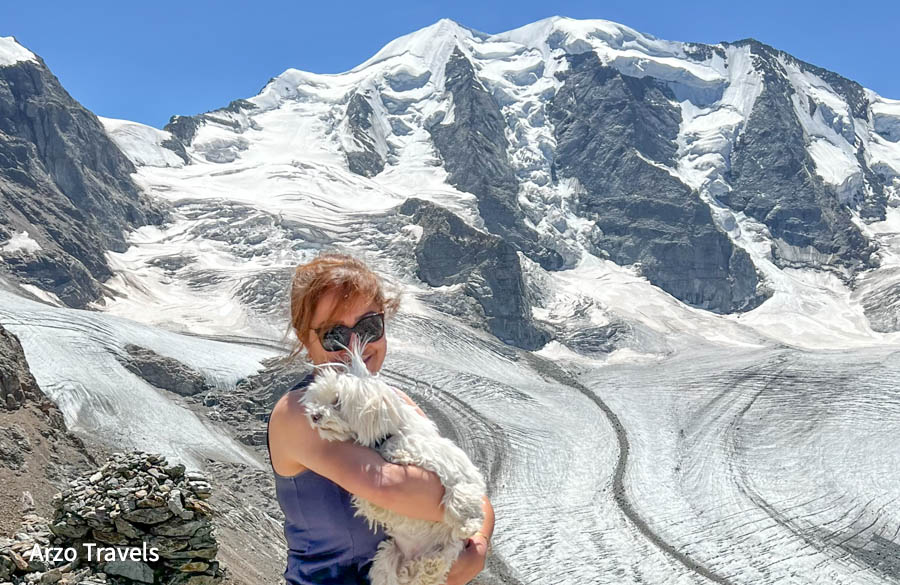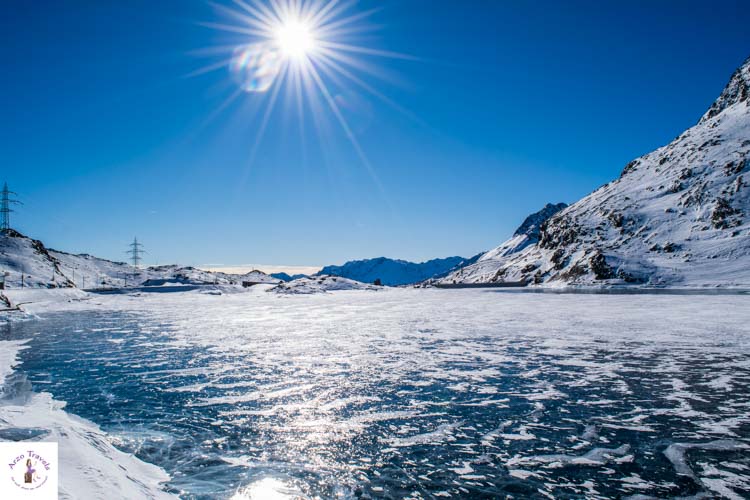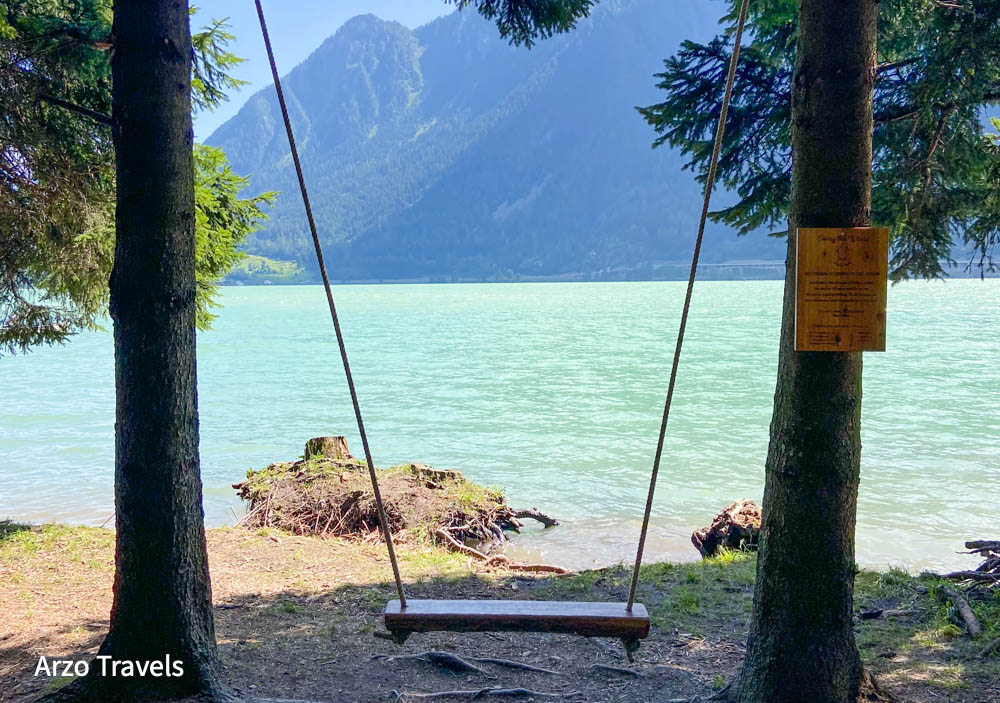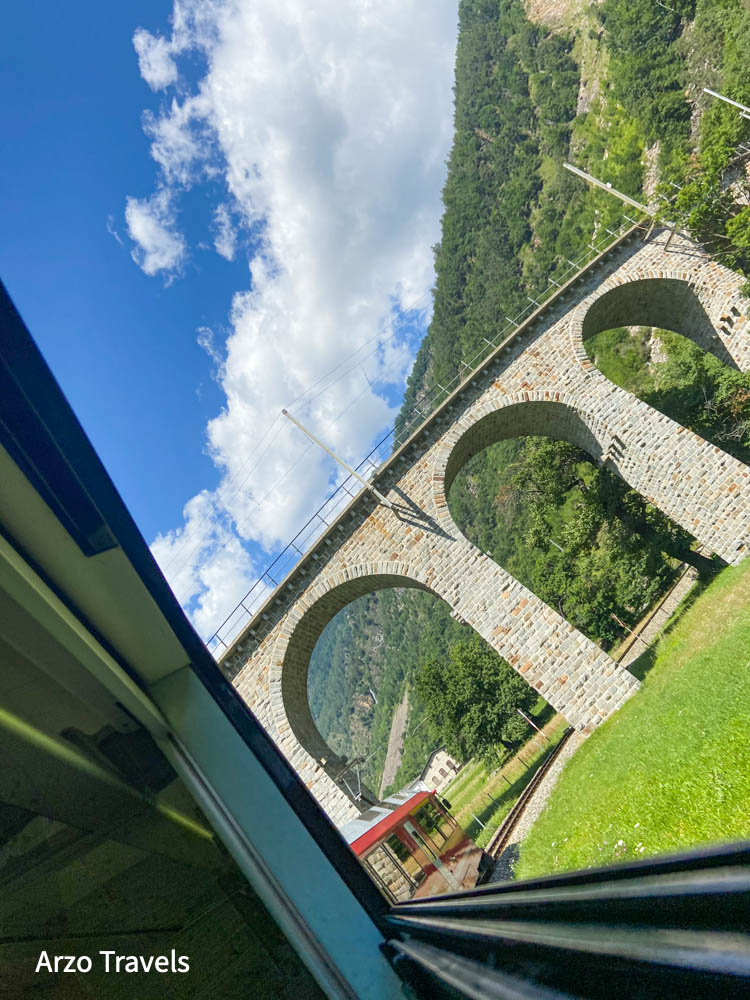REVIEW: BERNINA EXPRESS RIDE IN SWITZERLAND
The Bernina Express train ride in Switzerland is one of the most amazing, one of the most scenic, one of the most stunning train rides in the world.
It is such an impressive experience that I have done it many times. In summer. In winter. In fall. And of course in spring. Why? Because the Bernina Express is amazing – at any time of the year!
The Bernina Express window views are excellent and they will amaze you non-stop. Believe me, I am a self-proclaimed expert on train rides in Switzerland and this ride is top-notch.
In this post, I am sharing facts about the Bernina Express with you – data on the Bernina Express route, the best stops, services, the best sights along the way, and more. Also, I share some tips on how to avoid the costly reservation fees for the Bernina Express. Before talking about the main stops, here is some general info on the Bernina Express first.
Bernina Express Facts & Info
Here are some facts first and then we will talk about booking options and the different stops – including my own personal opinion!
From fancy St.Moritz (at 1,822 meters – 5,977 feet – above sea level), the Bernina Line goes up to Ozpizio Bernina at 2253 meters (7,391 feet) which is the highest regular train station in Europe. It is part of the 384 km (238 miles) long narrow gauge network of the Rhaetian Railway, which is a Swiss transport company that owns the largest network of all private railway operators in Switzerland.
ℹ️ The Bernina Express links together the towns of Chur in Switzerland, and Tirano in Italy with many amazing stops along the way.
ℹ️ St. Moritz is not an official stop – however, many people stop/start here as it is just a quick detour from Pontresina – one of the main stops.
ℹ️ The Bernina Express ride is 144 kilometers (90 miles).
ℹ️ The full journey takes 4 hours and 13 minutes and includes an impressive 196 bridges and 55 tunnels.
ℹ️ The entire route is managed by Rhaetian Railway, which has been named a UNESCO World Heritage Site in 2008.
ℹ️ It is split into two train lines. The first line (Albula) starts in Chur and connects with the secondary line (Bernina) in Pontresina. If you have your reservation for the Bernina Express you do not have to change trains though.
ℹ️ The Bernina Express offers panoramic views thanks to the large glass windows in both first and second-class carriages. This is also why the express trains in Switzerland are also known as PE (Panorama) trains (this info might be helpful when booking your train ride online).
ℹ️ There are also refreshments on offer, free Wi-Fi, as well as onboard tour guides that will narrate the important parts of the journey in English and German.
ℹ️ The route climbs at a maximum gradient of 7 percent. It reaches its highest elevation of 2,253 meters (7,391 feet) above sea level near the Bernina Pass at Ozpizio Bernina railway station. This is even higher than the Glacier Express route.
ℹ️ It departs from Chur once in the morning year-round (around 8:30 am) — and then again in the afternoon during the summer months.
ℹ️ There are also other train connections with the same route – however, you will have to change trains and there is no direct connection.
Where Can I Buy a Ticket For the Bernina Express?
If you have a Swiss Travel Pass, then you do not need to buy any ticket for the Bernina Express at all – the Bernina Express is free with the Swiss Travel Pass.
You must have a reservation though for the Bernina Express and this is not cheap. This is compulsory regarding the travel season, however, this fee differs slightly in price depending on when you travel. If you get off the train, you cannot just hop onto the next train to continue your journey – if you plan to do it, you will need another reservation.
Without a Swiss Travel Pass, you need to buy a ticket online or in person at the train station.
HOW MUCH IS THE BERNINA EXPRESS RESERVATION (ONE WAY)?
The reservation fee depends on the time (season) of your travel.
ℹ️ Summer: 1st June to 30th September – 26 CHF
ℹ️ Shoulder: 1st March to 31st May and 1st October to 31st October – 24 CHF
ℹ️ Winter: 1st November to 10th December – 20 CH and 11th December to 28th February – 10 CH
Here you can make reservations up to three months in advance.
You could buy your ticket for the full journey from Chur to Tirano, or end the trip early at one of the village stations along the way. However, keep in mind, if you get out at a stop your reservation for the rest of the journey will not be valid anymore and you will need a new reservation – which is not cheap.
How to avoid the fees for the Bernina Express? To avoid the costly reservation fee, do not take the official Bernina Express, but just take the local trains instead. Yes, it is that simple. There are local trains that go the exact same route. Actually, some Bernina Expresses have a few compartments where you can open windows and take even better pictures.
Okay, you do not have panoramic windows, but the route is the same. And the views are as stunning! Even without the panoramic windows. Actually, there are sometimes just a couple of compartments of the Bernina Express in between the regular trains.
Some Bernina Express trains have extra compartments that are actually local trains and can be used by those without reservation for the Bernina Express.
One thing to keep in mind is that there are local trains that have the same route but more stops and also there are no direct connections (except the one where a few compartments are sandwiched in between the Bernina Express). You would have to change trains if you want to do the whole tour with these local trains.
Bernina Express Route & Stops
These are the main stops that you can experience, with a full Bernina Express schedule available on the official website. The Bernina Express doesn’t stop as frequently – or for as long – as the regional trains that also make use of these lines. But there are a few short stops at picturesque villages along the way.
Chur
The official start/end of the Bernina Express is Chur. Chur is an Alpine city and the capital of the Graubünden canton (Grison). It is the oldest town in Switzerland and has a settlement history of over 5000 years. Its car-free old town (dating back to the 13th century) is quite nice, though it is not one of the best cities in Switzerland in my personal opinion.
However, it is the starting (or ending) point of this exceptional train ride, so you might want to spend a few hours here.
From here your journey starts and in the first few minutes the views are…not very pretty but after a while, the views get better. You start passing the famous Rhine River (but not the Rhine Gorge) and head towards Tiefencastel.
✔️ Stroll the old town, enjoy the views from Haldenhüttli, or get up the Brambrüesch mountain via cable car.
Tiefencastel
From Chur, you will quickly break out into the Swiss countryside before you reach the stop at Tiefencastel. During this section of the track, you will pass through a few tunnels and the well-known Domleschg Valley – famous for its castles.
Tiefencastel is part of the Albula district – it’s a small village with only 3% of its area actually devoted to settled land. The rest is made up of forests, rivers, glaciers, and mountains.
✔️ There are plenty of natural opportunities, including hiking and biking if you come during the warmer months.
- TIP: If you are short on time, and most of us have only a limited time in Switzerland, I would not get out here and just enjoy the window views.
Filisur
After setting off from Tiefencastel, you will make your way to Filisur. Personally, this part from Tiefencastel to Preda is one of my all-time favorite train rides in Switzerland!
Even after countless train rides, I am still amazed by these window views.
Before reaching Filisur station, admire the Landwasser Viaduct – one of the most famous bridges on the journey. The viaduct (bridge) spans the Landwasser Valley and the construction of the three main pillars in 1901/02 has been and is still impressive – it is one of the highlights of the Bernina Express.
The Alpine village of Filisur sits high up on a hill which provides a great vantage point for the surrounding landscapes. Here you can spot the convergence of the Albula/Alvra and Landwasser rivers.
✔️ There is plenty to do in both the summer and winter months. With long walking and hiking trails available, you can navigate your way through the surrounding Bergün/Filisur vacation region with ease.
ℹ️ TIP: You could get out at Filisur and walk to different vantage points – or you continue your trip and have some more amazing window views. Keep in mind, that the official Bernina Express does not run often, so you will have to use local trains if you want to continue your journey that day.
This makes a beautiful hike in summer or winter (I would calculate about 2 hours for the hike maybe 3-4 hours just to be on the safe side).
Bergün
The village of Bergün also goes by the Romansh name of Bravuogn and is high up in the Alps at an elevation of 1,367 meters (4,484 feet) above sea level. You will start gaining altitude on your way here via a series of spirals.
It is a small town that has remained relatively minor in terms of international tourism, despite being en route to St. Moritz.
✔️ If you’re interested to learn more about the history of the train routes in the area, the Albula Train Museum is a great place to stop. For the more adventurous, consider one of the tobogganing routes available in the surrounding countryside in the winter.
Pontresina
Then you are heading towards Pontresina, which is a mountain village, at 1,805 meters (5,921 feet), flanked by the Bernina massif near St.Moritz. It’s known for its Belle Epoque hotels and traditional Engadine stone houses with decorated facades.
In the summer months, it is a great base for some beautiful hikes because the Upper Engadine Valley is one of the most beautiful in all of Switzerland.
Between Pontresina to Bernina Diavolezza (stop on request only) you will have some more absolutely stunning window views. Especially the views of Mortaratsch Glacier are one of a kind.
If you are heading towards Tirano, then sit on the right side in direction of travel and you will see this stunning glacier for some time starting from Mortaratsch stop for a couple of kilometers.
ℹ️ TIP: The official Bernina Express route does not stop at the Mortaratsch train stop (local trains do), so if you want to hike around the area (which I highly recommend), take the local trains and stop there for 2-3 hours.
Bernina Diavolezza
Then you are headed towards Bernina Diavolezza. The ride from Pontresina is gorgeous but even more gorgeous it is to get off the station and take the cable car to enjoy some of the best mountain views in Switzerland.
You get close to the glacier and can even walk on it – even in the summer months. It is indeed an impressive attraction. However, since the Bernina Express does not run often (in summer only once a day), you would have to take local trains as well.
ℹ️ Also, this is a “stop on request” only, so make sure to press the stop button if you want to get out there.
Ospizio Bernina
And the train ride gets even better… The highest train stop on the Bernina Express (and in eastern Switzerland) is Ospizio Bernina – named after the nearby hostel. You’ll be able to enjoy great views of Lago Bianco (white lake).
At 2,253 meters (7,391 feet) above sea level, this is the highest point on the Bernina Express Rhaetian Railway network.
Since I have done the train rides so often, I am always surprised to see the watercolor changing. It never looks the same. So do not be surprised if it looks completely to what you see in my pictures. One thing I can tell you…Passing the lake is always one of the highlights and never fails to amaze me.
This stop also marks a switch in the culture and language use found throughout the rest of the journey — from German to Italian.
Alp Grum
After leaving Ospizio Bernina, you will only descend less than 200 meters before your next stop in Alp Grum (or Alp Grüm in Swiss German). It was created as a crossing loop along the route between Ospizio Bernina and Poschiavo on the Bernina line.
The main structure here is the railway station itself, which also houses the hotel and restaurant. From here, you will be able to enjoy unparalleled views of the Val Poschiavo and its Palu Glacier and Lago Palu.
Poschiavo
After the relative isolation experienced in the previous two stops, Poschiavo will feel almost like a bustling metropolis (yes, that is definitely exaggerated).
It is a section of Switzerland most well known for its Renaissance-style architecture and villas that were built by residents who had achieved wealth elsewhere in Europe.
The journey here includes many winding turns as you descend almost 1,000 meters in elevation to reach the town.
In Poschiavo are a couple of buildings (both churches and houses) that have become Swiss heritage sites of national significance. Taking a stroll through the town is a great way to experience these landmarks and get a feel for the Italian way of life that is dominant here.
ℹ️ TIP: Poschiavo is a great place to visit for two days or longer. Check out my Valposchiavo guide with tips on what to do there.
Le Prese
Le Prese is the final station before crossing over the Swiss border into Italy. It’s a village that still lies in the Val Poschiavo and is just a few kilometers after the previous stop. You’ll find it on the shores of Lake Poschiavo tucked between large Alpine mountains that provide a dramatic setting.
It was originally developed as a spa town but reached its peak of popularity in the early 1900s. It still holds cultural significance to this day and is the main stop between the Mediterranean environment of Italy and the Alpine glacier region of Bernina.
There is plenty to do in this town for those seeking relaxing natural experiences or more adventurous sports activities.
Tirano
Then you are about to cross the border – in Italy, a small town named Tirano is waiting for you. Tirano, with about 9000 inhabitants, is the last/first stop (unless you continue your journey by bus to Lugano) – before you reach it you will see the Brusio Circular Viaduct which is another highlight and often considered the most spectacular construction on the Bernina Line.
This viaduct turns around a 360-degree curve, lengthening the track so that it is possible to overcome the difference in altitude in the narrow Valposchiavo.
Then you will slowly enter Tirano – the southern point of departure of the Bernina Line. Just shortly before the train journey ends, you will pass the stunning pilgrimage church of Madonna di Tirano which dominates the romantic Old Town. Since you are in Italy now, it is all about ice cream, pizza, pasta, and the Dolce Vita.
CONCLUSION: IS THE BERNINA EXPRESS WORTH IT?
Yes, the Bernina Express is absolutely worth it. As an “experienced Switzerland train rider” I 100% vouch for this route. From the start to the beginning – the Bernina Express never fails to amaze me.
Especially in the fall – September, and October – as well as in the winter months (December-February), or the summer months (June-August) this train ride offers a lot of eye candy.
The reservation fee is quite high but you can easily avoid it by taking the regular, local trains that have the exact route (but a few more stops). As mentioned in other posts, train rides in Switzerland are not just to get from A to B but they are actually amazing experiences in themselves.
🎟️ GET YOUR SWISS TRAVEL PASS HERE
From Milan: Bernina and St. Moritz Day Tour by Scenic Train
READ MORE:
ℹ️ 5-day Switzerland itinerary
